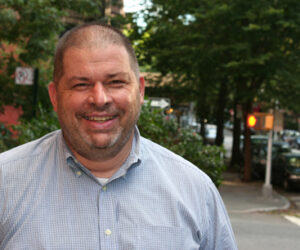Many people meet Michael Cairl for the first time as he sits on the stoop of his North Slope brownstone, rather than at a meeting of some local organization. “It’s great to sit and relax there on my ‘front porch’ on a nice day or evening, see people go by, feed the dogs, and watch the passing parade,” says Cairl, the new president of the Park Slope Civic Council.

“Park Slope is so much defined by the quality of that street life,” he adds. “People walk a lot, there are chance encounters every day. The neighborhood has a very human scale that’s best appreciated on foot, so it’s important that the very special street life we have be recognized and be nurtured.”
A member of the Civic Council for the last six years, Cairl was able to help nurture that aspect of Park Slope life as chair of the Council’s Livable Streets Committee since 2007. The group started as a reworking of the old Transportation Committee, after Council First Vice President Lauri Schindler and others chose to take a broader view of what comprises the streets — “the life of the streets and everything that makes it up, and not being so narrowly focused on a bike lane here or a bus route there.”
One of the committee’s biggest achievements, he says, has been the Council’s Forum on the Future of Fourth Avenue, held earlier this year. “In terms of the quality of discussions, the quality of presentations, and the fact that we were able to change the format so people would sit together and really interact — that was a major accomplishment.”
The Council held the gathering in part to help encourage new voices from the community when discussing the developments along the avenue. Following the forum, even more activity has begun to bubble: improvements to the subway station at Ninth Street, which the Civic Council has been spearheading; plans for planters and perhaps trees along the avenue; and, with funding from Assemblywoman Joan Millman, elimination of one left turn lane at Union Street, which was filled in to create a much safer pedestrian crossing. Plans are now in the works for more Civic Council events that will further this progress.
Cairl’s success with Livable Streets is somewhat ironic, considering that at first he was hesitant to take the position. “When Ken Freeman, my predecessor as president, asked me to take this on, I have to admit it was with some reluctance, because transportation is my thing. But this would be a learning and growing experience, and it was.”
Indeed, Cairl has been interested in transportation and transit since he was “‘yea high.’ I loved riding the subway, the noisy old buses, and I made my father take me down to where they were building the Verrazano Bridge every Sunday.” He was born in Park Slope’s Methodist Hospital in 1956. His mother was a Brooklyn Dodgers fan; his father, a New York Giants fan. “Sometimes I wonder how the two of them ever got together, but they actually met at a Pfizer picnic in Steeplechase Park.”
His family moved to Long Island in 1963 but still had relatives in the Slope, including the great aunt whose brownstone Cairl now owns. He went on to attend Fordham University and Columbia University, worked in the Pentagon for Navy procurement, then moved back to New York for an opportunity with a Queens-based defense contractor.
That company “decided to diversify into nondefense areas, including the rail market and projects for NYC Transit.” For a while, Cairl handled both transit and defense contracts, but for the last decade he’s been focused solely on transit. Currently, he is handling oversight of light rail projects in Norfolk, Va., and Salt Lake City on behalf of the Federal Transit Administration.
Since returning to his home borough, one of Cairl’s most important memories has been how the entire neighborhood came together to honor Squad 1 on Union Street after Sept. 11, 2001. “I saw so many of my neighbors come out along Seventh Avenue for a candlelight vigil for the victims and for the firefighters,” he says. “It’s important for the community to come together like that when we need it.”
With all that in mind, Cairl wants to help the Civic Council develop a sense of community. “One of my big goals as president is to grow the membership and make it more diverse, to make people throughout the community not only more aware of who we are and what we do — from grants to the Halloween Parade to Civic Sweep and so on — but also to take part in it themselves or form new initiatives on their own.”
The new president is very interested in reaching out to parts of the community that are often difficult hard to engage in civic efforts, such as younger residents or people who might not have English as their first language. “I think we tend to be defined, rightly or wrongly, as a group of white middle-aged homeowners in the Center Slope,” he says. “We really need to act decisively to broaden our membership.”
The Fourth Avenue Forum was an example of that effort. “One of the most gratifying things besides the big turnout was all the new faces, and we need to build on that.” Based on that sort of result, “there seems to be a desire in previously untapped parts of the community to have an organization they can identify with, even if they can’t do a lot. An organization that will take the desire to do something with Fourth Avenue, say, or do battle with subway or bus service, or keep the neighborhood cleaner or to engage in practical sustainability measures.”
Cairl is also very excited about the Council’s recently formed Sustainability Committee. One concern that the group is exploring is a way to cut down on the local waste stream, by getting tote bags into people’s hands and reducing the demand for plastic bags. “That’s a simple, low-tech, very achievable thing,” he notes, “and we need to be doing more of that.”
Transportation remains an important issue for Cairl. The majority of people who live in Park Slope do not own cars, so there is a mix of modes of transportation that does not exist in the suburbs or even in lots of other cities. “Add to that, in the past few years, the cycling community has very successfully transformed from just being a recreational activity to a vital mode of transportation, and a very sensible and economical one. We’ve seen the mix of how people get from point A to point B, and it has become much more complex.”
In addition, streets function as a gathering place in the neighborhood, so that level of engaging street life needs to be maintained. “It’s one of the things that makes this neighborhood attractive and a good place.”
Cairl is very active in leadership roles with many other organizations throughout the community: the Grand Army Plaza Coalition, the Brooklyn Greenway Initiative, the Gowanus Community Stakeholder Group, LAMBDA Independent Democrats, and Independent Neighborhood Democrats. He is also an avid biker, photographer, foodie, and jazz junkie. A brownstone owner, Cairl shares his house with his partner and five curious cats.
“As a son of Park Slope,” he says, “being Civic Council president would be both a huge honor and a big kick. I have every intention that we will have fun working on the Council. To me, this is a great accomplishment for someone who takes his neighborhood seriously and calls it home.
“At the end of the day, if we’re moving forward and accomplishing these broad goals, it’ll be a good thing for the Civic Council and a very good thing for Park Slope.”
— Written and photographed by David Herman
from the September 2010 Civic News

